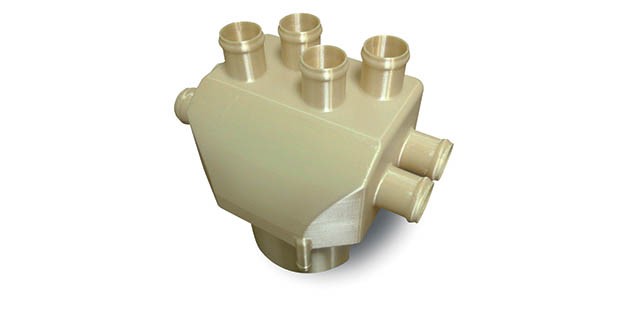
Lightweighting, maintaining compliance in an ever-changing regulatory environment, and finding manufacturing and cost efficiencies are the biggest challenges faced by aerospace designers. Parts and systems that address these challenges demand a deep understanding of material capabilities and the processing methods that are best suited to each part or system. The following case studies illustrate the ways in which the right materials, married with the right application and manufacturing processes, can help achieve those critical objectives.
 Improving design, manufacturing
Improving design, manufacturing
When Taylor-Deal Aviation LLC in Dallas, needed a way to produce small volume parts quickly and cost-effectively, it turned to SABIC’s Innovative Plastics business and Stratasys Inc. SABIC, Pittsfield, Mass., offered strong, lightweight, flame-retardant ULTEM 9085 resin, a polyetherimide (PEI) material. That resin, coupled with fused deposition modeling (FDM) technology from Minneapolis-based Stratasys, enabled Taylor-Deal Aviation to create specialty fluid- and air-handling parts in hours rather than weeks. Additionally, the material met the latest industry regulations for flame-smoke-toxicity.
Leveraging the benefits
The properties of ULTEM 9085 resin are suited to the aerospace industry and to FDM processing. Stratasys’ FDM additive manufacturing process creates three-dimensional parts, layer-by-layer, directly from CAD files for use in design verification, prototyping and development. Geometric limitations in custom aircraft designs can make traditional manufacturing methods ineffective. Stratasys’ FDM technology solved two key challenges – greater part complexity and consolidation of numerous parts. In addition, the process avoided costly tooling for fiberglass parts and machining costs for metallic parts, which are often too expensive for low production runs.
Combining the ULTEM resin with a nimble processing method helped Taylor-Deal Aviation create novel designs and rapidly supply customers with lightweight components that improve fuel efficiency.
Compatibility with regulations
Unlike polyetheretherketone (PEEK), ULTEM 9085 resin is flame retardant without additives and compliant with Federal Aviation Agency (FAA) FAR 25.853 and Ohio State University (OSU) 55/55. The resin also provides a high strength-to-weight ratio, elevated thermal resistance, high strength and stiffness, and broad chemical resistance.
FDM technology using ULTEM resin is suitable for manufacturing components with complex geometries – such as parts and ductwork to handle air or fluids in hidden spaces – offering a solution for the aerospace, mass transportation, automotive, and healthcare industries where it is vital to remove manufacturing costs, eliminate weight, improve design freedom, or meet safety standards.

